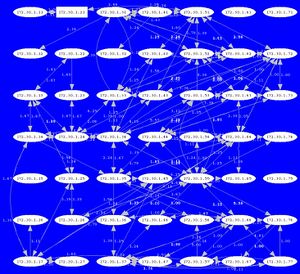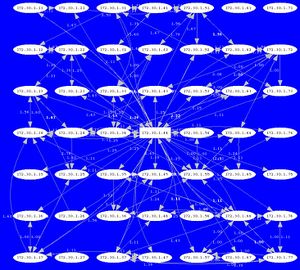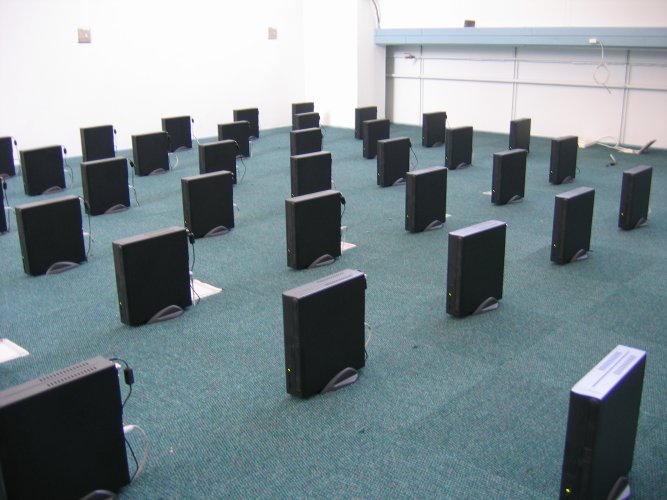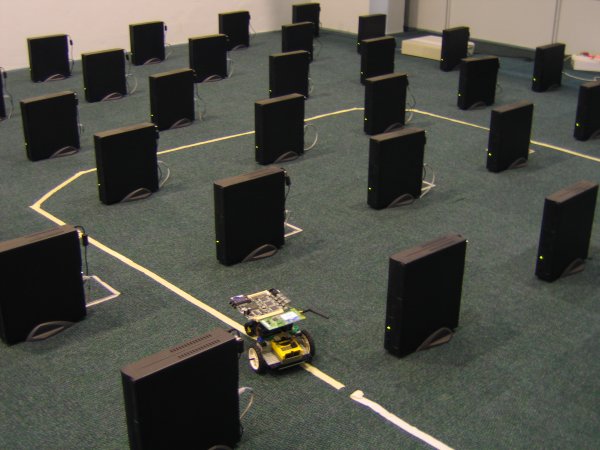49-node Indoor Mesh: Difference between revisions
No edit summary |
|||
| Line 1: | Line 1: | ||
==Introduction== | |||
Their are a plethora of mesh routing protocols being used worldwide today (See: [[Wireless Mesh Networking]]). Some of these have become popular due to organizations taking the trouble to convert the specification into usable code that can be run on a wireless router while other protocols remain purely academic and have only been run on computer simulations. There is also a new 802.11s working group which is seeking to create [[Mesh Standards]]. | Their are a plethora of mesh routing protocols being used worldwide today (See: [[Wireless Mesh Networking]]). Some of these have become popular due to organizations taking the trouble to convert the specification into usable code that can be run on a wireless router while other protocols remain purely academic and have only been run on computer simulations. There is also a new 802.11s working group which is seeking to create [[Mesh Standards]]. | ||
[[Image:Massive-mesh-layout.jpg | [[Image:Massive-mesh-layout.jpg]] | ||
[[Image:Robot00001-small.jpg]] | |||
Protocols for which code is available will be run on the massive mesh indoor testbed which consists of a grid of 49 nodes. Some code will also be ported to run on the massive mesh - for example HSLS is being ported to FreeBSD and Linux. Performance metrics will be gathered such as average throughput and latency together with their variance. We aim to also test [[Mobility]] using roaming nodes built onto [[Robots]] like the line follower Lego robot shown in the picture. Each protocol is generally suited to different scenarios, some scale better to very large meshes due to less broadcast traffic others are better at handling mobility. Once all these metrics are gathered, better protocol choices can be made when a mesh network is built. | Protocols for which code is available will be run on the massive mesh indoor testbed which consists of a grid of 49 nodes. Some code will also be ported to run on the massive mesh - for example HSLS is being ported to FreeBSD and Linux. Performance metrics will be gathered such as average throughput and latency together with their variance. We aim to also test [[Mobility]] using roaming nodes built onto [[Robots]] like the line follower Lego robot shown in the picture. Each protocol is generally suited to different scenarios, some scale better to very large meshes due to less broadcast traffic others are better at handling mobility. Once all these metrics are gathered, better protocol choices can be made when a mesh network is built. | ||
==[[OLSR Dot Draw]] visualizations== | ==[[OLSR Dot Draw]] visualizations== | ||
| Line 14: | Line 13: | ||
The | The image shows mesh configuration with an omni attached to node 44. | ||
[[Image:Office-mesh-omni44.jpg|thumb|center]] | [[Image:Office-mesh-omni44.jpg|thumb|center]] | ||
Other visualization tools are also being worked on. | |||
Other visualization are being worked on | |||
Revision as of 16:31, 23 November 2005
Introduction
Their are a plethora of mesh routing protocols being used worldwide today (See: Wireless Mesh Networking). Some of these have become popular due to organizations taking the trouble to convert the specification into usable code that can be run on a wireless router while other protocols remain purely academic and have only been run on computer simulations. There is also a new 802.11s working group which is seeking to create Mesh Standards.
Protocols for which code is available will be run on the massive mesh indoor testbed which consists of a grid of 49 nodes. Some code will also be ported to run on the massive mesh - for example HSLS is being ported to FreeBSD and Linux. Performance metrics will be gathered such as average throughput and latency together with their variance. We aim to also test Mobility using roaming nodes built onto Robots like the line follower Lego robot shown in the picture. Each protocol is generally suited to different scenarios, some scale better to very large meshes due to less broadcast traffic others are better at handling mobility. Once all these metrics are gathered, better protocol choices can be made when a mesh network is built.
OLSR Dot Draw visualizations
The image shows mesh configuration with no omni antennas attached.

The image shows mesh configuration with an omni attached to node 44.

Other visualization tools are also being worked on.

